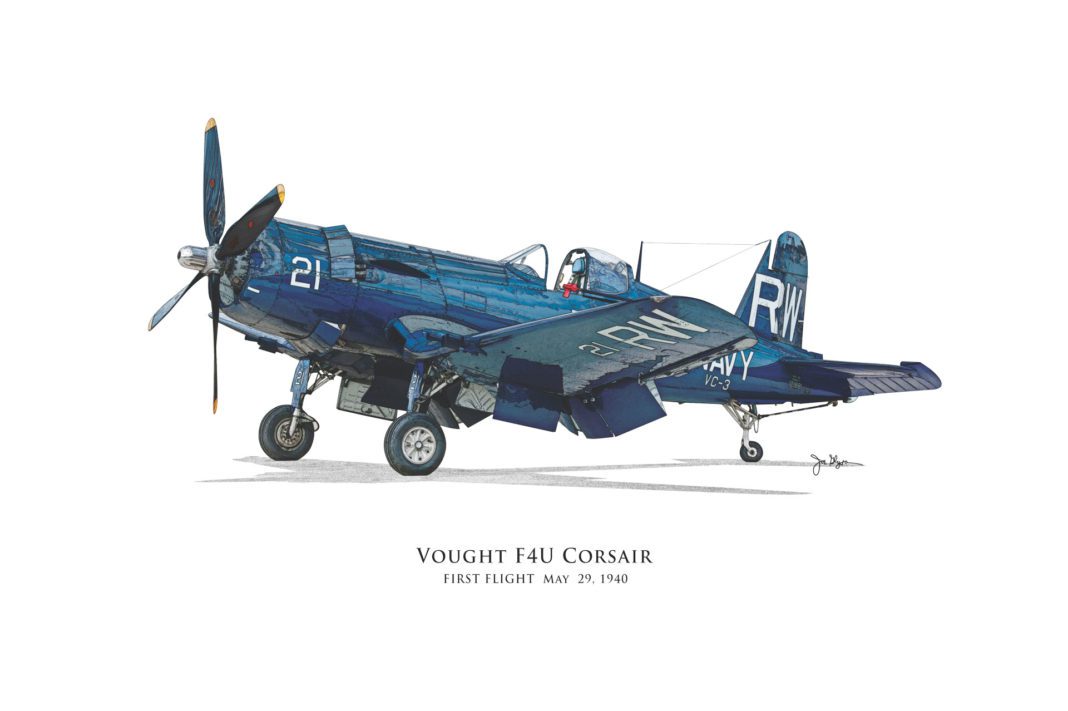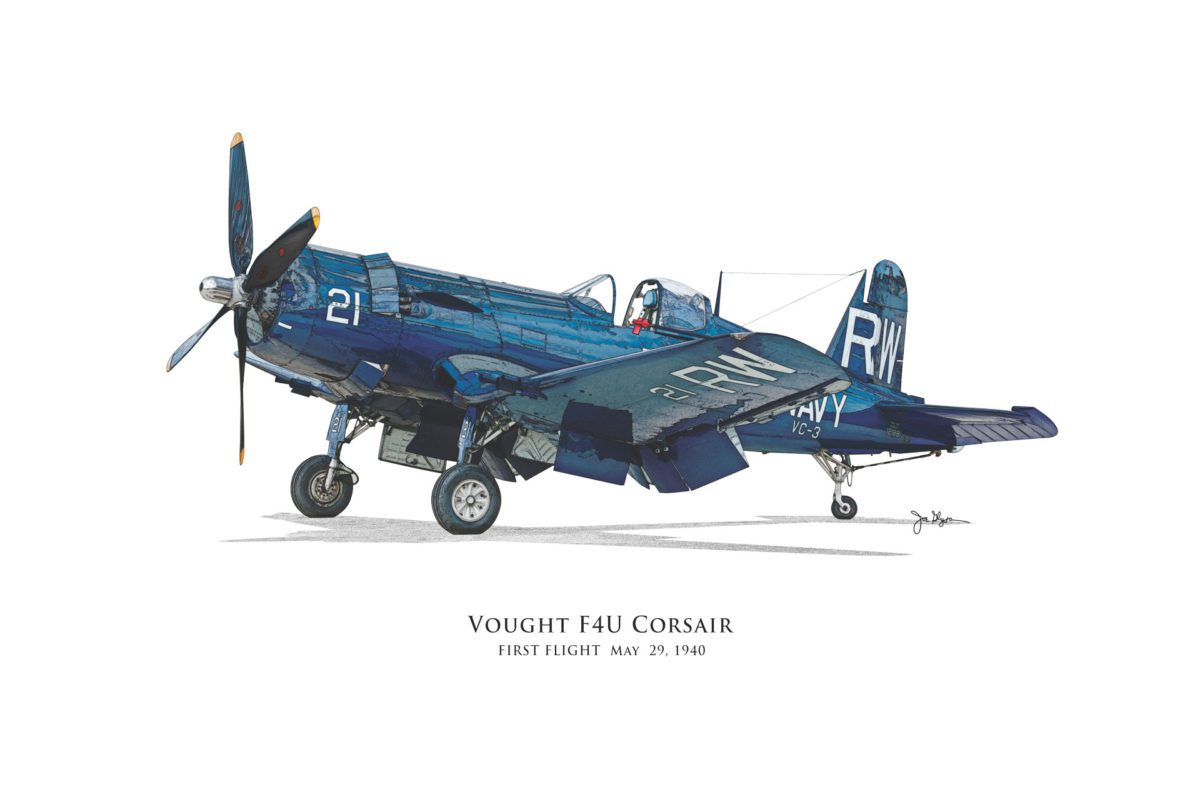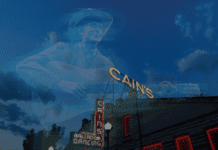Before you dive into Jenks resident Joe Glyda’s new oversized hardcover publication, WWII Aviation Artwork and the Stories Behind These Beautiful Birds, take a look at the lime green bands that mark both ends of the place where spine and pages meet. As is the case with each of the vintage aircraft covered inside, there’s a story there.
“When I was younger,” he says, “my brothers and I built airplane models, and so did our dad. He’d always paint the inside of the wheel wells on his models lime green. I remember asking him, ‘Dad, isn’t it like the bottom of a car, all black and dirty under there?’
“He’d say, ‘No, no, no. That’s where the zinc chromate is. That’s the paint protection they use for the metal, before they paint the airplane. It kept the plane from falling apart.’
“So, when this book was being designed, the designer asked me, ‘What color would you like the headband?’
“I said, ‘What’s the headband?’ And she told me it was what keeps the book from falling apart. So I thought, well, let’s just make it lime-green, as a tribute to my dad.”
That’s not the only thing about WWII Aviation Artwork inspired by Glyda’s father. In the book’s first chapter, Glyda tells about the slideshows his dad used to put together for family and friends, presentations consisting of pictures the elder Glyda had taken of planes and ships while serving as a Navy mechanic in the late ’40s and early ’50s.
“A darkened room combined with the sound of the projector fan made the images come alive,” wrote Glyda. “They appeared to be larger than life on the screen (at least they were to me).”
From a very early age, it was clear to Glyda that his father loved airplanes, and he passed that love to Joe and his brothers in any number of ways – including taking them on day trips to watch the planes come in at Midway Airport in Chicago, not far from where the family lived.
Glyda also inherited an affinity for photography from his father, and it was also in Chicago that he turned that interest into a career, beginning a 36-year run as a photographer for Kraft Foods.
“Kraft had 2,700 products then, and I did everything from brochures to packaging – the photos for mac and cheese boxes, cheesecake, Cool Whip, DiGiorno pizza, Parkay margarine,” he says. “There were flyers that came out in newspapers every Sunday called FSI’s, free-standing inserts, and we used to photograph all of those in our in-house studio. I could be working on three or four different projects a week.
“I always say that I photograph things that don’t talk back – food, architecture, aviation – but looking back on my career, I did photograph a lot of people,” he adds. “Kraft was a sponsor of NASCAR’s Roush Racing Team from 2001 to 2009, and I got to work with [drivers] Mark Martin, Matt Kenseth, Kurt Busch and Greg Biffle. I’d photograph the races, and the drivers and VIPs. So I would photograph people. I just liked photographing food so much better.”
After taking early retirement from Kraft in 2009, Glyda continued to concentrate on those “things that don’t talk back” as a freelance commercial photographer, becoming especially well-known as a leader in digital photography. And he began to explore his own projects, a quest that once again involved his love of aircraft – especially those of the World War II era.
“I was enthralled by how many airplanes were built in such a small amount of time, between 1939 and 1945,” he notes. “So I went to the Reno [Nevada] Air Show in 2014 and photographed my first World War II plane, the [North American] T-6 [Texan]. The last one I took was of the [Catalina] PBY. That was in December 2020 at Fantasy of Flight in Florida.
“During 2019, I began acquiring information on the planes, and I found too many inconsistencies on the web, so I was going to the library and pulling as much as I could. I made a storyboard in my office, with two-by-eight foam boards, and I’d take each picture and the story behind it and pin them to the board. I’d read about each plane for a week or two, and then I’d write about it.”
When the pandemic hit, making library visits problematic, Glyda found that people around the country who shared his passion were also eager to share books on the subject from their personal libraries. So he was able to keep his research going.
He was also able to continue converting his photos into digital artwork for the book, something he’d decided to do early on.
“As I was photographing these airplanes, there would be so much distraction in the background,” says Glyda. “You can’t walk up to someone at an air show and say, ‘Hey, could you move? I’m trying to get a picture here.’” So sometimes I’d stand there for an hour, waiting for people to get out of the way, just so I could get the shot I needed. There were always people in the background, buildings in the background, other things that distracted from the airplane.”
After working with the photograph of the first plane he’d shot, the T-6, seeking ways to make it stand out from the background clutter, he hit upon the idea of turning the aircraft images into digital artwork, which would allow them to stand alone on a page.
“The first eight airplanes I did looked great,” he recalls. “And I thought, ‘Okay, this is the direction I want to go.’”
That was in 2014. Five years later, after photographing many more planes, he went back to the computer – only to find that the two software programs he’d used to digitize those first eight images were no longer available. He ended up retrofitting a computer to 2014 and keeping it offline, so that he could re-install those outdated programs and use them to keep the artwork consistent.
Although art and photography are the focus of Glyda’s big coffee-table-sized volume, he also includes personal stories from those who flew some of the planes, utilizing letters, log books, family memories – and occasionally, a face-to-face interview. The best example of the latter comes in the chapter on the Vought F4U Corsair, which is enhanced by the memories of a 94-year-old veteran named Clayburn Harris. It was an encounter with Harris in Tulsa that convinced Glyda the detailed pictures of planes in his book would benefit from what he terms “humanistic relevance.”
In Harris’s case, that meant stories from his time in the Marines focused around the Corsair, even though Harris served after World War II.
“I wasn’t planning on putting stories in the book,” he says. “It was going to be a photograph book, and then it was going to be an artwork book. But when Clay Harris started giving me his story, and I was almost crying as he told it, I thought, ‘Oh, my gosh. I need to have some stories in here.’”
In late August, not long after the official publication of WWII Aviation Artwork, Glyda appeared at a signing event at the Tulsa Air and Space Museum. He plans to make appearances at similar institutions around the country, especially those that have several World War II planes on exhibit.
“I want to get to my core audience,” he notes. “So if they see those airplanes and say, ‘I wish I could take a book of these planes home with me’ – well, they can.”
For more information on WWII Aviation Artwork and the Stories Behind These Beautiful Birds, as well as other vintage-aircraft themed art products, visit Joe Glyda’s website, wwiiaviation.art.
Photos courtesy Glyda





























